Synergistic Evolution of Soil and Vegetation in Reclamation Areas with Different Developmental Years on Hengsha Island
Abstract
1. Introduction
- (1)
- Characterize soil physicochemical and vegetation patterns across reclamation ages;
- (2)
- Quantify soil–vegetation correlations and their directional interactions;
- (3)
- Provide mechanistic insights to inform nature-based restoration and sustainable management of coastal reclamation ecosystems.
2. Materials and Methods
2.1. Study Area
2.2. Soil Sampling and Analysis
2.3. Remote Sensing Data Acquisition and Processing
2.4. Statistical Analysis
3. Results
3.1. Soil Physicochemical Differences Across Reclamation Stages
3.2. Differences in Vegetation Cover Across Reclamation Stages
3.3. Relationships Between Soil Physicochemical Properties and Vegetation Cover
4. Discussion
4.1. Effects of Reclamation Stages on Soil Physicochemical Properties
4.2. Effects of Reclamation Stages on Vegetation Cover
4.3. Synergistic Evolution of Soil and Vegetation in Coastal Reclamation Zones
5. Conclusions
Author Contributions
Funding
Institutional Review Board Statement
Data Availability Statement
Conflicts of Interest
Abbreviations
| NDVI | Normalized difference vegetation index |
| FVC | Fractional vegetation cover |
| EC | Electrical conductivity |
| TSS | Total soil salinity |
| OM | Organic matter |
| TN | Total nitrogen |
| HN | Hydrolyzable nitrogen |
| TP | Available phosphorus |
| AP | Available phosphorus |
| TK | Total potassium |
| AK | Available potassium |
Appendix A
| Soil Physicochemical Properties | Y3 | Y7 | Y10 | Y15 | Changing Trends |
|---|---|---|---|---|---|
| pH | 8.82 ± 0.32 | 8.45 ± 0.38 | 8.15 ± 0.29 | 8.36 ± 0.16 | Decrease |
| Electrical conductivity (mS/cm) | 0.67 ± 0.46 | 0.44 ± 0.44 | 0.47 ± 0.46 | 0.14 ± 0.02 | Decrease |
| Total soil salinity (mg/kg) | 1.44 ± 0.14 | 1.32 ± 0.17 | 1.28 ± 0.32 | 0.91 ± 0.02 | Decrease |
| Organic matter (mg/kg) | 6442.50 ± 2097.88 | 10605.00 ± 1841.20 | 16899.00 ± 6557.79 | 11053.39 ± 2116.29 | Increase |
| Hydrolyzable nitrogen (mg/kg) | 250.03 ± 180.76 | 358.96 ± 103.44 | 551.64 ± 234.4 | 989.09 ± 223.75 | Increase |
| Total nitrogen (mg/kg) | 250.03 ± 180.76 | 358.96 ± 103.44 | 551.64 ± 234.40 | 989.09 ± 223.75 | Increase |
| Available phosphorus (mg/kg) | 6.59 ± 1.67 | 6.88 ± 1.65 | 6.01 ± 1.48 | 13.28 ± 0.81 | Increase |
| Total potassium (mg/kg) | 160.00 ± 30.00 | 160.00 ± 20.00 | 160.00 ± 30.00 | 610.00 ± 70.00 | Increase |
| Total potassium (mg/kg) | 18.47 ± 2.78 | 20.84 ± 2.47 | 22.21 ± 2.44 | 23.87 ± 1.87 | Increase |
| Available potassium (mg/kg) | 135.05 ± 49.71 | 127.63 ± 38.97 | 155.90 ± 73.20 | 87.22 ± 28.25 | Increased initially and then declined |
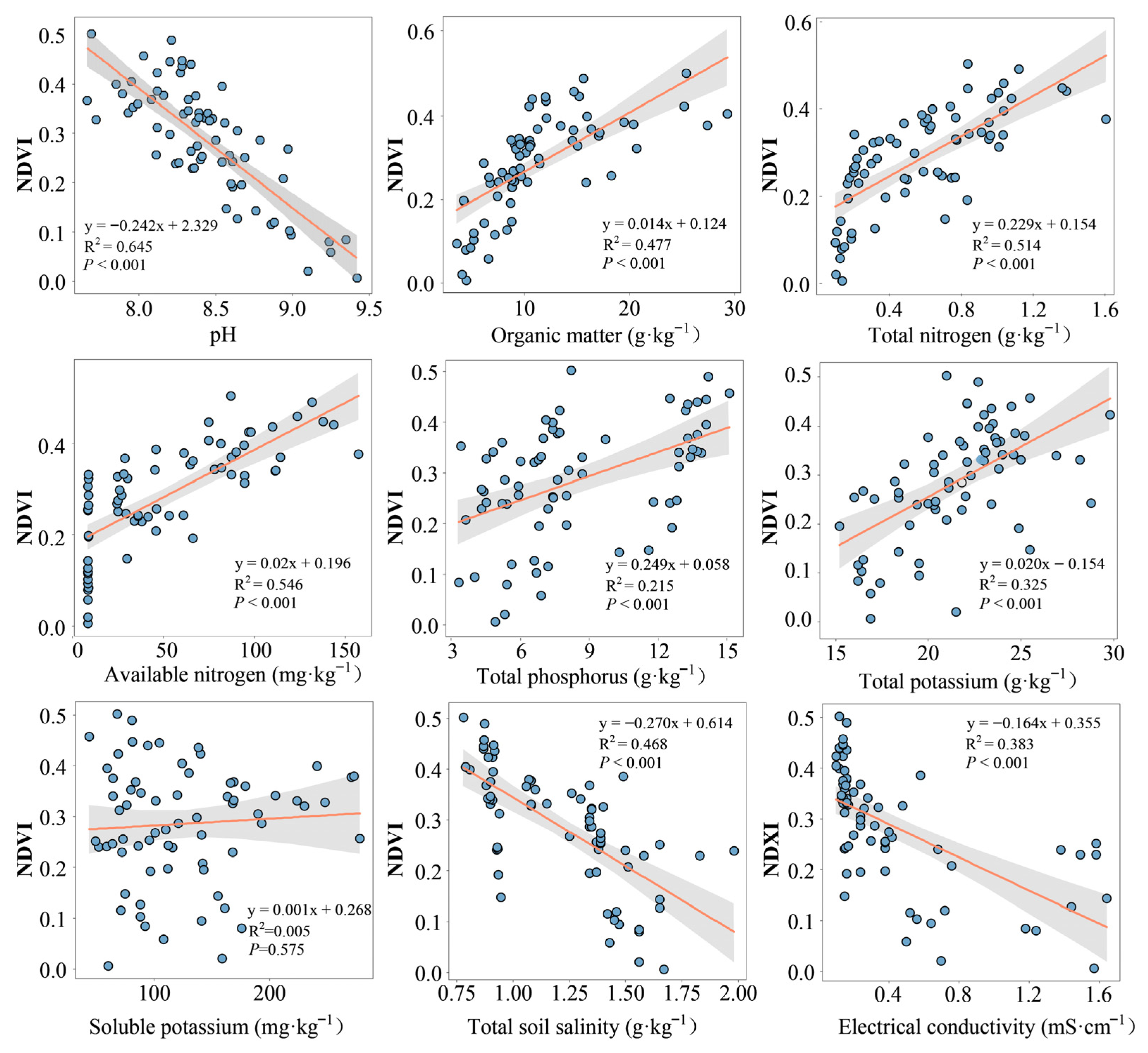
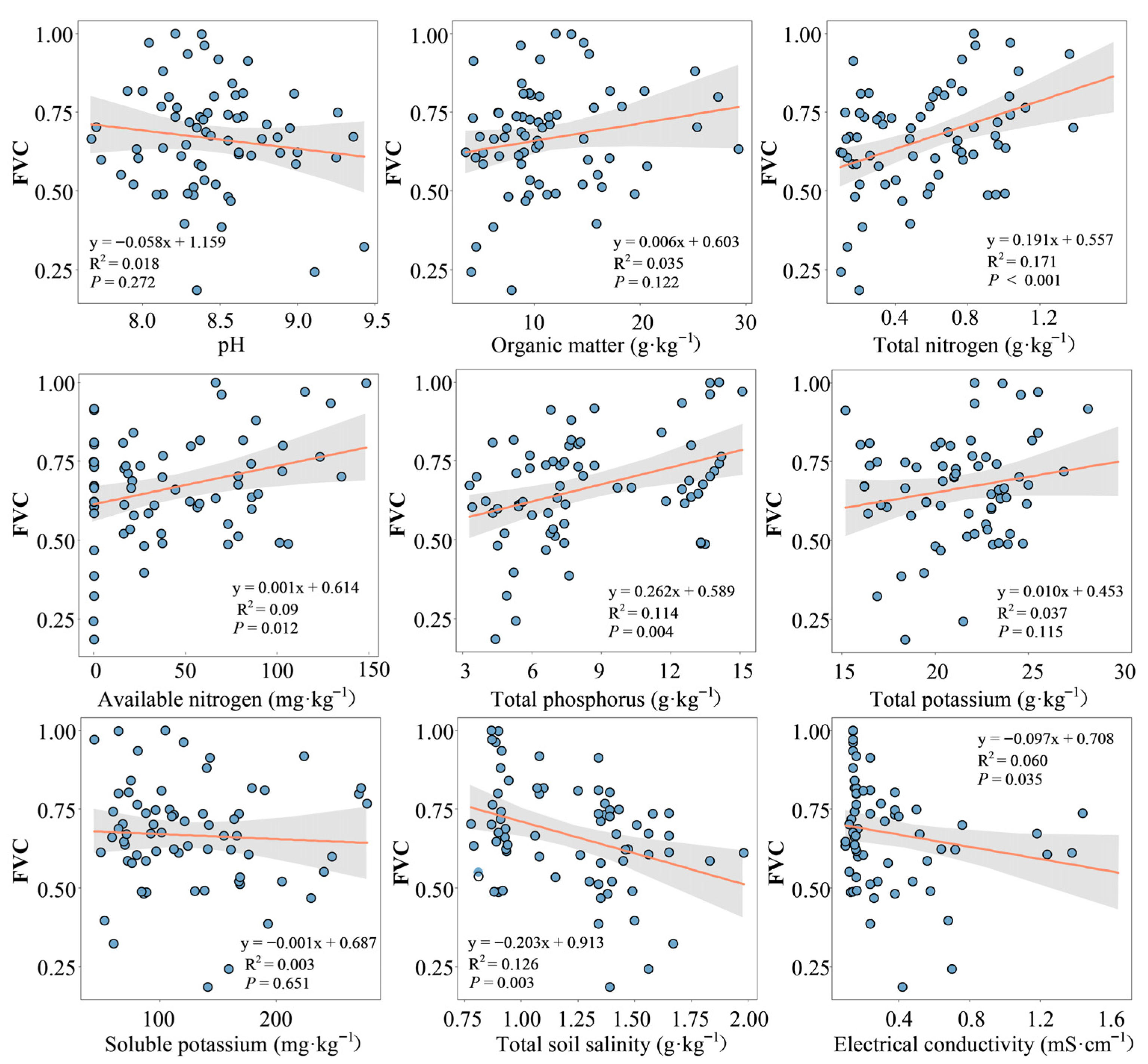

References
- Li, S.; Shao, Y.; Hong, M.; Zhu, C.; Dong, B.; Li, Y.; Lin, Y.; Wang, K.; Gan, M.; Zhu, J.; et al. Impact mechanisms of urbanization processes on supply-demand matches of cultivated land multifunction in rapid urbanization areas. Habitat Int. 2023, 131, 102726. [Google Scholar] [CrossRef]
- Wang, J.; Zhang, X. Land-based urbanization in China: Mismatched land development in the post-financial crisis era. Habitat Int. 2022, 125, 102598. [Google Scholar] [CrossRef]
- Zhang, Y.; Xie, H. Interactive relationship among urban expansion, economic development, and population growth since the reform and opening up in China: An analysis based on a vector error correction model. Land 2019, 8, 153. [Google Scholar] [CrossRef]
- Shi, K.; Chen, Y.; Yu, B.; Xu, T.; Li, L.; Huang, C.; Liu, R.; Chen, Z.; Wu, J. Urban expansion and agricultural land loss in China: A multiscale perspective. Sustainability 2016, 8, 790. [Google Scholar] [CrossRef]
- Yan, F.; Wang, X.; Huang, C.; Zhang, J.; Su, F.; Zhao, Y.; Lyne, V. Sea reclamation in mainland China: Process, pattern, and management. Land Use Policy 2023, 127, 106555. [Google Scholar] [CrossRef]
- Sengupta, D.; Chen, R.; Meadows, M.E. Building beyond land: An overview of coastal land reclamation in 16 global megacities. Appl. Geogr. 2018, 90, 229–238. [Google Scholar] [CrossRef]
- Xie, J.; Yuan, Y.; Wang, X.; Zhang, R.; Zhong, R.; Zhai, J.; Lu, Y.; Tao, J.; Pu, L.; Huang, S. Impact of Coastal Beach Reclamation on Seasonal Greenhouse Gas Emissions: A Study of Diversified Saline–Alkaline Land Use Patterns. Agriculture 2025, 15, 1403. [Google Scholar] [CrossRef]
- Zhang, Y.; Chen, R.; Wang, Y. Tendency of land reclamation in coastal areas of Shanghai from 1998 to 2015. Land Use Policy 2020, 91, 104370. [Google Scholar] [CrossRef]
- Wu, T.; Zhu, J.; Ma, R.; Qiu, W.; Yuan, R. Freshwater resources around the reclaimed new land on the Eastern Hengsha Shoal in the Changjiang estuary. Front. Mar. Sci. 2023, 10, 1302091. [Google Scholar] [CrossRef]
- Zhang, J.; Sha, C.; Li, S.; Wang, M.; Wang, Q.; Wang, Q.; Su, J.; Shen, C.; Huang, S. Chronosequence Changes of Soil Organic Carbon in Salt Marshes under Artificial Intervention: A Case Study of Hengsha Island in the Yangtze Estuary. Sustainability 2024, 16, 4553. [Google Scholar] [CrossRef]
- Ma, R.; Zhu, J. Water and Salt Transports in the Hengsha Channel of Changjiang Estuary. J. Mar. Sci. Eng. 2022, 10, 72. [Google Scholar] [CrossRef]
- Yu, W.; Zhang, D.; Liao, J.; Ma, L.; Zhu, X.; Zhang, W.; Hu, W.; Ma, Z.; Chen, B. Linking ecosystem services to a coastal bay ecosystem health assessment: A comparative case study between Jiaozhou Bay and Daya Bay, China. Ecol. Indic. 2022, 135, 108530. [Google Scholar] [CrossRef]
- Kumar, R.; Singh, A.; Bhardwaj, A.K.; Kumar, A.; Yadav, R.K.; Sharma, P.C. Reclamation of salt-affected soils in India: Progress, emerging challenges, and future strategies. Land Degrad. Dev. 2022, 33, 2169–2180. [Google Scholar] [CrossRef]
- Wang, C.; Kuzyakov, Y. Energy use efficiency of soil microorganisms: Driven by carbon recycling and reduction. Glob. Change Biol. 2023, 29, 6170–6187. [Google Scholar] [CrossRef]
- Reithmaier, G.M.; Cabral, A.; Akhand, A.; Bogard, M.J.; Borges, A.V.; Bouillon, S.; Burdige, D.J.; Call, M.; Chen, N.; Chen, X.; et al. Carbonate chemistry and carbon sequestration driven by inorganic carbon outwelling from mangroves and saltmarshes. Nat. Commun. 2023, 14, 8196. [Google Scholar] [CrossRef]
- Osland, M.J.; Gabler, C.A.; Grace, J.B.; Day, R.H.; McCoy, M.L.; McLeod, J.L.; From, A.S.; Enwright, N.M.; Feher, L.C.; Stagg, C.L.; et al. Climate and plant controls on soil organic matter in coastal wetlands. Glob. Change Biol. 2018, 24, 5361–5379. [Google Scholar] [CrossRef] [PubMed]
- Gong, J.; Liu, W.; Li, W.; Cui, L. Sediment organic carbon dynamics and accumulation in estuarine mangrove wetlands. Catena 2025, 259, 109317. [Google Scholar] [CrossRef]
- Zheng, Y.; Cao, X.; Zhou, Y.; Li, Z.; Yang, Y.; Zhao, D.; Li, Y.; Xu, Z.; Zhang, C.-S. Effect of planting salt-tolerant legumes on coastal saline soil nutrient availability and microbial communities. J. Environ. Manag. 2023, 345, 118574. [Google Scholar] [CrossRef] [PubMed]
- Cho, K.H.; Beon, M.-S.; Jeong, J.-C. Dynamics of soil salinity and vegetation in a reclaimed area in Saemangeum, Republic of Korea. Geoderma 2018, 321, 42–51. [Google Scholar] [CrossRef]
- Beon, M.-S.; Cho, K.H.; Kim, H.O.; Oh, H.-K.; Jeong, J.-C. Mapping of vegetation using multi-temporal downscaled satellite images of a reclaimed area in Saemangeum, Republic of Korea. Remote Sens. 2017, 9, 272. [Google Scholar] [CrossRef]
- Caldwell, T.G.; Young, M.H.; McDonald, E.V.; Zhu, J. Soil heterogeneity in Mojave Desert shrublands: Biotic and abiotic processes. Water Resour. Res. 2012, 48, W09551. [Google Scholar] [CrossRef]
- Chua, S.; Switzer, A.D.; Gouramanis, C.; Dixit, Y.; Bird, M.I.; Horton, B.P. Coastal response to Holocene Sea-level change: A case study from Singapore. Mar. Geol. 2023, 465, 107146. [Google Scholar] [CrossRef]
- Ba, Q.; Wang, B.; Zhu, L.; Fu, Z.; Wu, X.; Wang, H.; Bi, N. Rapid change of vegetation cover in the Huanghe (Yellow River) mouth wetland and its biogeomorphological feedbacks. Catena 2024, 238, 107875. [Google Scholar] [CrossRef]
- Suir, G.M.; Saltus, C.L.; Reif, M.K. Remote sensing-based structural and functional assessments of Phragmites australis diebacks in the Mississippi River Delta. Ecol. Indic. 2022, 135, 108549. [Google Scholar] [CrossRef]
- Zhang, B.; Hu, G.; Xu, C.; Hu, C.; Zhong, C.; Chen, S.; Zhang, Z. Effects of Natural Vegetation Restoration on Soil Physicochemical Properties in Tropical Karst Areas, Southwestern China. Forests 2024, 15, 1270. [Google Scholar] [CrossRef]
- Biederman, L.A.; Whisenant, S.G. Using Mounds to Create Microtopography Alters Plant Community Development Early in Restoration. Restor. Ecol. 2011, 19, 53–61. [Google Scholar] [CrossRef]
- Li, J.; Wang, S.; Tang, Y.; Du, Y.; Xu, L.; Hu, J.; Zhu, C. Coastal reclamation alters soil organic carbon dynamics: A meta-analysis in China. Catena 2024, 240, 107975. [Google Scholar] [CrossRef]
- Wang, F.; Wang, T.; Gustave, W.; Wang, J.; Zhou, Y.; Chen, J. Spatial-temporal patterns of organic carbon sequestration capacity after long-term coastal wetland reclamation. Agric. Ecosyst. Environ. 2023, 341, 108209. [Google Scholar] [CrossRef]
- Maynard, J.J.; Levi, M.R. Hyper-temporal remote sensing for digital soil mapping: Characterizing soil-vegetation response to climatic variability. Geoderma 2017, 285, 94–109. [Google Scholar] [CrossRef]
- Xu, N.; Jia, D.; Ding, L.; Wu, Y. Continuously tracking the annual changes of the Hengsha and Changxing islands at the Yangtze River estuary from 1987 to 2016 using Landsat imagery. Water 2018, 10, 171. [Google Scholar] [CrossRef]
- Li, X.; Qi, X.; Liu, X.; Khalid, M.; Ye, J.; Romantschuk, M.; Chen, F.; Hua, Y.; Hui, N. PET addition delays the composting mature process and promotes microbiota associated with plastic degradation in plastisphere. J. Clean. Prod. 2023, 389, 136066. [Google Scholar] [CrossRef]
- Li, X.; Ma, J.; Yang, Y.; Hou, H.; Liu, G.-J.; Chen, F. Short-term response of soil microbial community to field conversion from dryland to paddy under the land consolidation process in North China. Agriculture 2019, 9, 216. [Google Scholar] [CrossRef]
- Moravec, D.; Komárek, J.; Medina, S.L.-C.; Molina, I. Effect of atmospheric corrections on NDVI: Intercomparability of Landsat 8, Sentinel-2, and UAV sensors. Remote Sens. 2021, 13, 3550. [Google Scholar] [CrossRef]
- Li, X.; Yu, M.; Ma, J.; Luo, Z.; Chen, F.; Yang, Y. Identifying the relationship between soil properties and rice growth for improving consolidated land in the Yangtze River Delta, China. Sustainability 2018, 10, 3072. [Google Scholar] [CrossRef]
- Mu, X.; Yang, Y.; Xu, H.; Guo, Y.; Lai, Y.; McVicar, T.R.; Xie, D.; Yan, G. Improvement of NDVI mixture model for fractional vegetation cover estimation with consideration of shaded vegetation and soil components. Remote Sens. Environ. 2024, 314, 114409. [Google Scholar] [CrossRef]
- Mu, X.; Song, W.; Gao, Z.; McVicar, T.R.; Donohue, R.J.; Yan, G. Fractional vegetation cover estimation by using multi-angle vegetation index. Remote Sens. Environ. 2018, 216, 44–56. [Google Scholar] [CrossRef]
- Wan, D.; Yu, P.; Kong, L.; Zhang, J.; Chen, Y.; Zhao, D.; Liu, J. Effects of inland salt marsh wetland degradation on plant community characteristics and soil properties. Ecol. Indic. 2024, 159, 111582. [Google Scholar] [CrossRef]
- Zhang, K.; Xia, J.; Su, L.; Gao, F.; Cui, Q.; Xing, X.; Dong, M.; Li, C. Effects of microtopographic patterns on plant growth and soil improvement in coastal wetlands of the Yellow River Delta. Front. Plant Sci. 2023, 14, 1162013. [Google Scholar] [CrossRef] [PubMed]
- Ma, H.; Thompson, A.; Hall, S.J.; Wang, J.; Xiao, Y.; Liu, C.-Q.; Chen, C. Enrichment of metastable iron minerals in global coastal wetlands. Nat. Geosci. 2025, 18, 885–892. [Google Scholar] [CrossRef]
- Hua, J.; Feng, Y.; Jiang, Q.; Bao, X.; Yin, Y. Shift of bacterial community structure along different coastal reclamation histories in Jiangsu, Eastern China. Sci. Rep. 2017, 7, 10096. [Google Scholar] [CrossRef]
- Sun, B.; Gao, C.; Zhang, Y. Soil quality evaluation in typical coastal reclamation zones based on weighted Topsis method. Chin. J. Eco-Agric. 2018, 26, 284–293. [Google Scholar] [CrossRef]
- Xu, Y.; Pu, L.; Zhang, R.; Zhu, M.; Zhang, M.; Bu, X.; Xie, X.; Wang, Y. Effects of Agricultural Reclamation on Soil Physicochemical Properties in the Mid-Eastern Coastal Area of China. Land 2021, 10, 142. [Google Scholar] [CrossRef]
- Graham, N.T.; Hejazi, M.I.; Chen, M.; Davies, E.G.; Edmonds, J.A.; Kim, S.H.; Turner, S.W.; Li, X.; Vernon, C.R.; Calvin, K.; et al. Humans drive future water scarcity changes across all Shared Socioeconomic Pathways. Environ. Res. Lett. 2020, 15, 014007. [Google Scholar] [CrossRef]
- Imbrenda, V.; Coluzzi, R.; Lanfredi, M.; Loperte, A.; Satriani, A.; Simoniello, T. Analysis of landscape evolution in a vulnerable coastal area under natural and human pressure. Geomat. Nat. Haz. Risk 2018, 9, 1249–1279. [Google Scholar] [CrossRef]
- Zhang, Y.; Hartemink, A.E.; Vanwalleghem, T.; Bonfatti, B.R.; Moen, S. Climate and land use changes explain variation in the A horizon and soil thickness in the United States. Commun. Earth Environ. 2024, 5, 129. [Google Scholar] [CrossRef]
- Cui, J.; Liu, C.; Li, Z.; Wang, L.; Chen, X.; Ye, Z.; Fang, C. Long-term changes in topsoil chemical properties under centuries of cultivation after reclamation of coastal wetlands in the Yangtze Estuary, China. Soil Tillage Res. 2012, 123, 50–60. [Google Scholar] [CrossRef]
- Li, J.; Pu, L.; Zhu, M.; Zhang, J.; Li, P.; Dai, X.; Xu, Y.; Liu, L. Evolution of soil properties following reclamation in coastal areas: A review. Geoderma 2014, 226, 130–139. [Google Scholar] [CrossRef]
- Yang, R.; Song, S.; Chen, S.; Du, Z.; Kong, J. Adaptive evaluation of green manure rotation for a low fertility farmland system: Impacts on crop yield, soil nutrients, and soil microbial community. Catena 2023, 222, 106873. [Google Scholar] [CrossRef]
- Liu, H.; Deng, Y.; Liu, X. The contribution of forest and grassland change was greater than that of cropland in human-induced vegetation greening in China, especially in regions with high climate variability. Sci. Total Environ. 2021, 792, 148408. [Google Scholar] [CrossRef] [PubMed]
- Bununu, Y.; Bello, A.; Ahmed, A. Land cover, land use, climate change and food security. Sustain. Earth Rev. 2023, 6, 16. [Google Scholar] [CrossRef]
- Burden, A.; Garbutt, A.; Evans, C.D. Effect of restoration on saltmarsh carbon accumulation in Eastern England. Biol. Lett. 2019, 15, 20180773. [Google Scholar] [CrossRef]
- Wang, Z.; Liu, K. Effect of Intertidal Vegetation (Suaeda salsa) Restoration on Microbial Diversity in the Offshore Areas of the Yellow River Delta. Plants 2024, 13, 213. [Google Scholar] [CrossRef]
- Wen, Y.; Bernhardt, E.S.; Deng, W.; Liu, W.; Yan, J.; Baruch, E.M.; Bergemann, C.M. Salt effects on carbon mineralization in southeastern coastal wetland soils of the United States. Geoderma 2019, 339, 31–39. [Google Scholar] [CrossRef]
- Cai, Y.; Zhang, F.; Duan, P.; Jim, C.Y.; Chan, N.W.; Shi, J.; Liu, C.; Wang, J.; Bahtebay, J.; Ma, X. Vegetation cover changes in China induced by ecological restoration-protection projects and land-use changes from 2000 to 2020. Catena 2022, 217, 106530. [Google Scholar] [CrossRef]
- Radočaj, D.; Šiljeg, A.; Marinović, R.; Jurišić, M. State of major vegetation indices in precision agriculture studies indexed in web of science: A review. Agriculture 2023, 13, 707. [Google Scholar] [CrossRef]
- Brown, J.C.; Kastens, J.H.; Coutinho, A.C.; Victoria, D.d.C.; Bishop, C.R. Classifying multiyear agricultural land use data from Mato Grosso using time-series MODIS vegetation index data. Remote Sens. Environ. 2013, 130, 39–50. [Google Scholar] [CrossRef]
- Li, G.; Zhang, F.; Jing, Y.; Liu, Y.; Sun, G. Response of evapotranspiration to changes in land use and land cover and climate in China during 2001–2013. Sci. Total Environ. 2017, 596, 256–265. [Google Scholar] [CrossRef] [PubMed]
- Gaw, L.Y.-F.; Richards, D.R. Development of spontaneous vegetation on reclaimed land in Singapore measured by NDVI. PLoS ONE 2021, 16, e0245220. [Google Scholar] [CrossRef]
- Smith, H.W.; Ashworth, A.J.; King, S.; Kreman, C.; Miller, D.M.; Nalley, L.L.; Owens, P.R. Remote sensing reveals trends in vegetative recovery and land cover transformation post-reclamation at tar creek superfund site. Discov. Geosci. 2024, 2, 53. [Google Scholar] [CrossRef]
- Van Asselen, S.; Verburg, P.H. Land cover change or land-use intensification: Simulating land system change with a global-scale land change model. Glob. Change Biol. 2013, 19, 3648–3667. [Google Scholar] [CrossRef]
- Huete, A.; Didan, K.; Miura, T.; Rodriguez, E.P.; Gao, X.; Ferreira, L.G. Overview of the radiometric and biophysical performance of the MODIS vegetation indices. Remote Sens. Environ. 2002, 83, 195–213. [Google Scholar] [CrossRef]
- Pettorelli, N.; Vik, J.O.; Mysterud, A.; Gaillard, J.-M.; Tucker, C.J.; Stenseth, N.C. Using the satellite-derived NDVI to assess ecological responses to environmental change. Trends Ecol. Evol. 2005, 20, 503–510. [Google Scholar] [CrossRef] [PubMed]
- Wang, G.; Wang, M.; Xue, Z.; Ren, Z.; Jiang, M.; Otte, M. Vegetation regulates element composition of soils by enhancing organic matter accumulation in the salt marshes of liao river delta, China. Front. Mar. Sci. 2022, 9, 888605. [Google Scholar] [CrossRef]
- Arif, Y.; Singh, P.; Siddiqui, H.; Bajguz, A.; Hayat, S. Salinity induced physiological and biochemical changes in plants: An omic approach towards salt stress tolerance. Plant Physiol. Biochem. 2020, 156, 64–77. [Google Scholar] [CrossRef]
- Xie, W.; Yang, J.; Yao, R.; Wang, X. Spatial and temporal variability of soil salinity in the Yangtze River estuary using electromagnetic induction. Remote Sens. 2021, 13, 1875. [Google Scholar] [CrossRef]
- Rengel, Z.; Marschner, P. Nutrient availability and management in the rhizosphere: Exploiting genotypic differences. New Phytol. 2005, 168, 305–312. [Google Scholar] [CrossRef]
- Córdova, S.C.; Olk, D.C.; Dietzel, R.N.; Mueller, K.E.; Archontouilis, S.V.; Castellano, M.J. Plant litter quality affects the accumulation rate, composition, and stability of mineral-associated soil organic matter. Soil Biol. Biochem. 2018, 125, 115–124. [Google Scholar] [CrossRef]
- Kumawat, K.C.; Nagpal, S.; Sharma, P. Potential of plant growth-promoting rhizobacteria-plant interactions in mitigating salt stress for sustainable agriculture: A review. Pedosphere 2022, 32, 223–245. [Google Scholar] [CrossRef]
- Liu, S.; Zhang, Q.; Li, Z.; Tian, C.; Qiao, Y.; Du, K.; Cheng, H.; Chen, G.; Li, X.; Li, F. Soil salinity weakening and soil quality enhancement after long-term reclamation of different croplands in the Yellow River Delta. Sustainability 2023, 15, 1173. [Google Scholar] [CrossRef]
- Zhang, X.; Zhang, Z.; Wang, W.; Fang, W.-T.; Chiang, Y.-T.; Liu, X.; Ju, H. Vegetation successions of coastal wetlands in southern Laizhou Bay, Bohai Sea, northern China, influenced by the changes in relative surface elevation and soil salinity. J. Environ. Manag. 2021, 293, 112964. [Google Scholar] [CrossRef]
- Yu, Y.; Zhu, R.; Liu, D.; Gao, Z.; Zhao, J.; Ma, D.; Wang, L.; Rodrigo-Comino, J. Understanding the balance between soil conservation and soil water storage capacity during the process of vegetation restoration in semi-arid watersheds in the Loess Plateau, China. Land Degrad. Dev. 2023, 34, 5805–5815. [Google Scholar] [CrossRef]
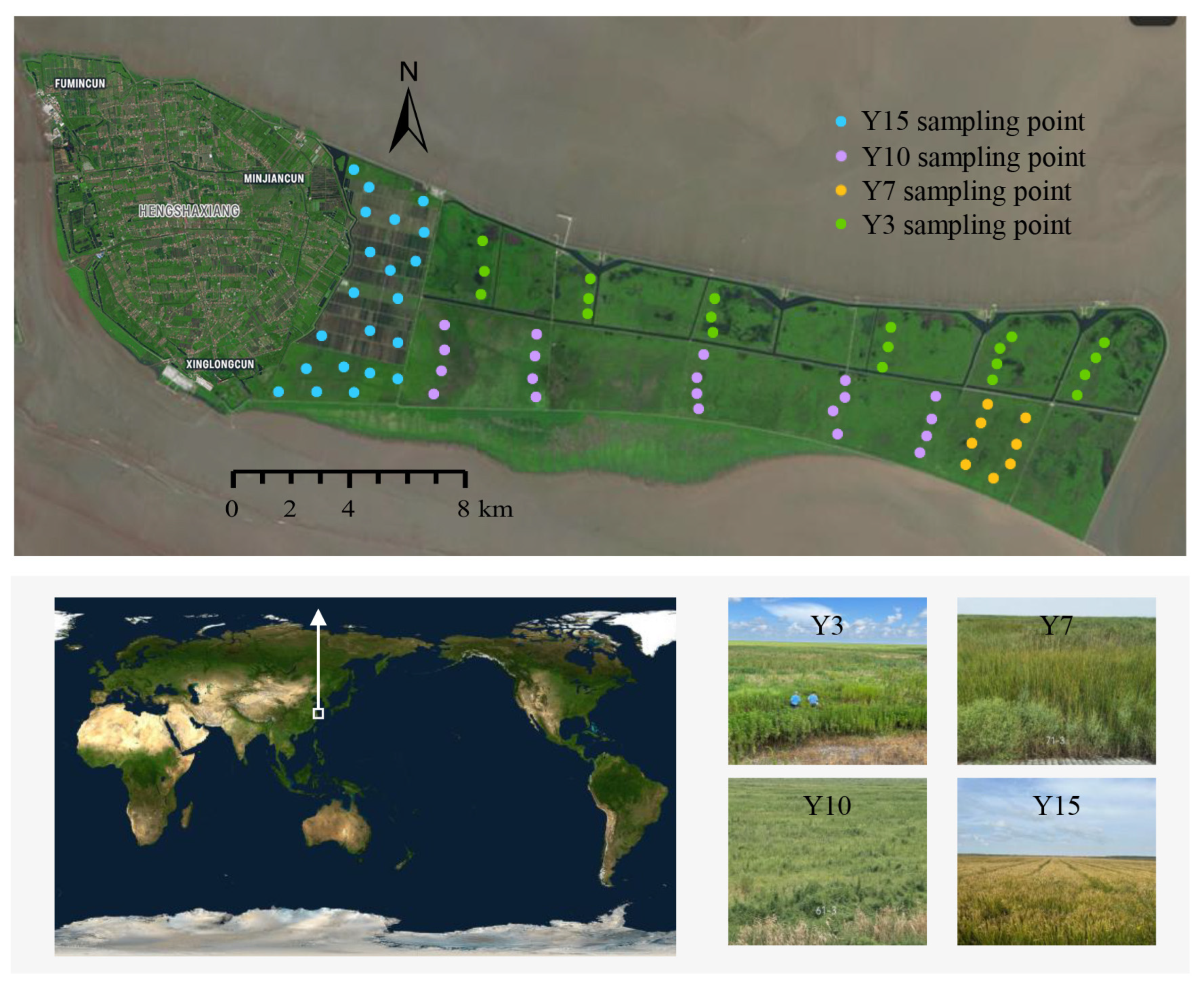
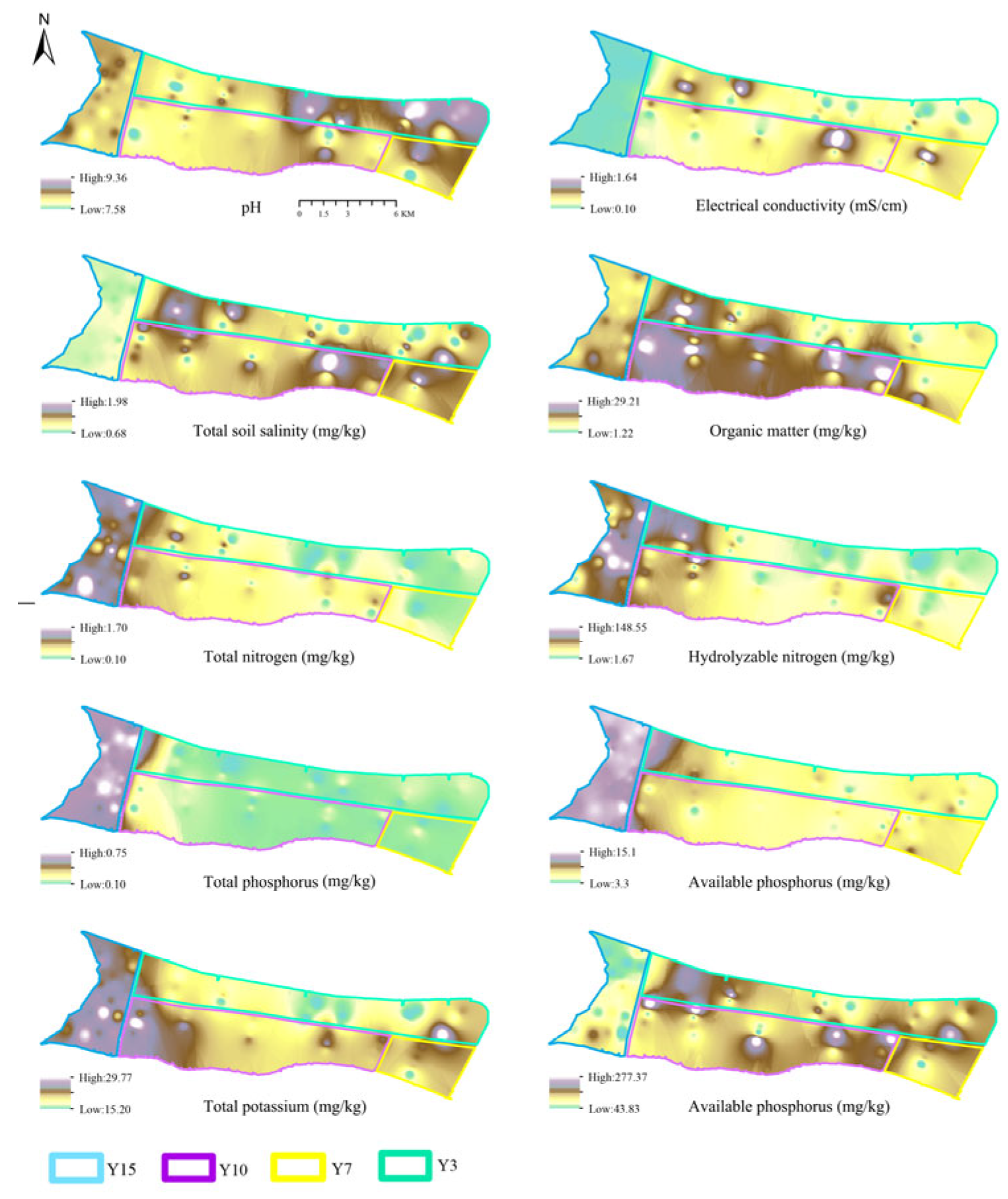

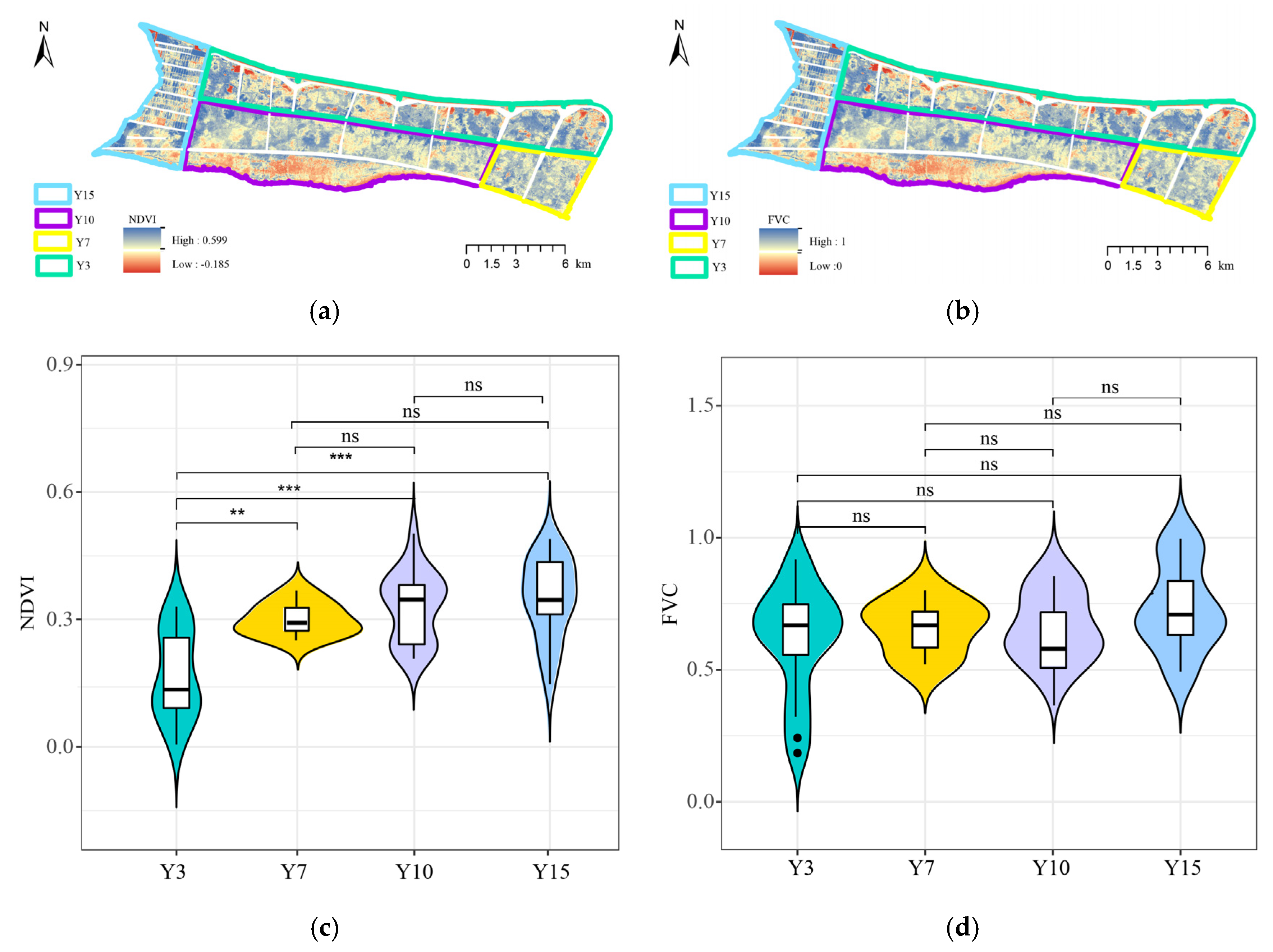
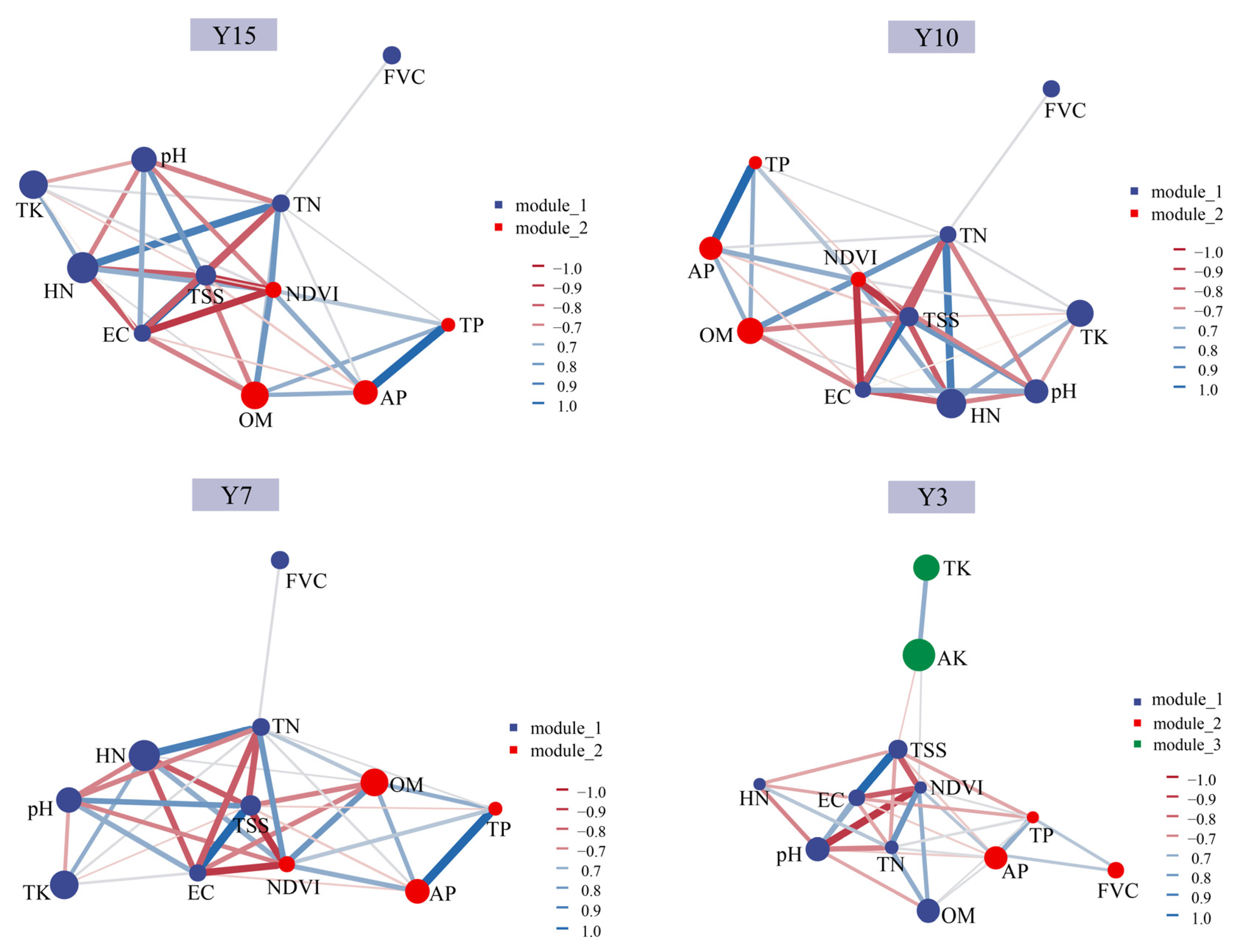
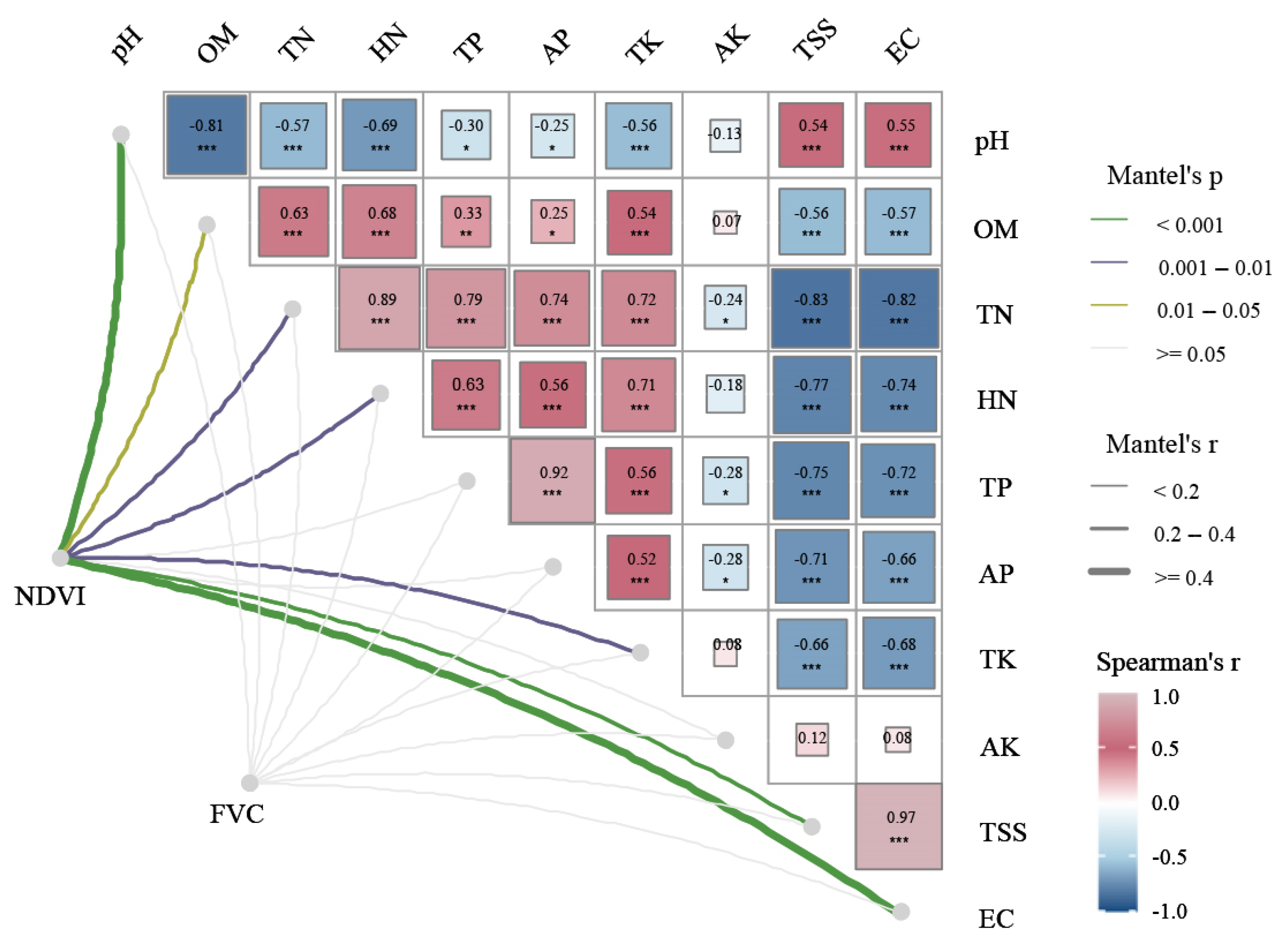

| Area | Reclamation Project | Construction Time | Development Time | Number of Sample Points | Soil Group | Soil Characteristics |
|---|---|---|---|---|---|---|
| Long-term recovery | Zone 3 | 2005–2010 | 15 years (Y15) | 21 | Paddy soil | Topsoil induced through rice cultivation |
| Mid-term recovery | Zone 6 | 2011–2015 | 10 years (Y10) | 20 | Coastal solonchaks | Native topsoil, transitioning towards more fertile soils with reduced |
| Short-term recovery | Zone 7 | 2015–2017 | 7 years (Y7) | 8 | Coastal solonchaks | Native topsoil, saline, undergoing natural recovery |
| New reclamation | Zone 8 | 2016–2021 | 3 years (Y3) | 20 | Coastal solonchaks | Newly formed soils, highly saline and barren |
Disclaimer/Publisher’s Note: The statements, opinions and data contained in all publications are solely those of the individual author(s) and contributor(s) and not of MDPI and/or the editor(s). MDPI and/or the editor(s) disclaim responsibility for any injury to people or property resulting from any ideas, methods, instructions or products referred to in the content. |
© 2025 by the authors. Licensee MDPI, Basel, Switzerland. This article is an open access article distributed under the terms and conditions of the Creative Commons Attribution (CC BY) license (https://creativecommons.org/licenses/by/4.0/).
Share and Cite
Li, X.; Zhang, Y.; Liu, D.; Zheng, X.; Khalid, M.; Lv, W.; Song, K. Synergistic Evolution of Soil and Vegetation in Reclamation Areas with Different Developmental Years on Hengsha Island. Agriculture 2025, 15, 2196. https://doi.org/10.3390/agriculture15212196
Li X, Zhang Y, Liu D, Zheng X, Khalid M, Lv W, Song K. Synergistic Evolution of Soil and Vegetation in Reclamation Areas with Different Developmental Years on Hengsha Island. Agriculture. 2025; 15(21):2196. https://doi.org/10.3390/agriculture15212196
Chicago/Turabian StyleLi, Xiaoxiao, Yue Zhang, Dong Liu, Xianqing Zheng, Muhammad Khalid, Weiguang Lv, and Ke Song. 2025. "Synergistic Evolution of Soil and Vegetation in Reclamation Areas with Different Developmental Years on Hengsha Island" Agriculture 15, no. 21: 2196. https://doi.org/10.3390/agriculture15212196
APA StyleLi, X., Zhang, Y., Liu, D., Zheng, X., Khalid, M., Lv, W., & Song, K. (2025). Synergistic Evolution of Soil and Vegetation in Reclamation Areas with Different Developmental Years on Hengsha Island. Agriculture, 15(21), 2196. https://doi.org/10.3390/agriculture15212196






